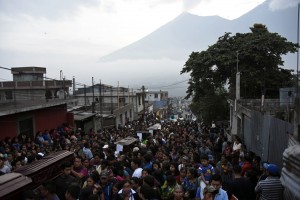Guatemala’s Volcano of Fire
June 8, 2018
At around noon on Sunday, June 3, the Volcán de Fuego (Volcano of Fire) erupted in southern Guatemala, a nation in Central America. The explosive eruption forced a massive ash cloud more than 6 miles (10 kilometers) into the air, blotting out the sun and darkening the immediate area. The volcano also spewed lava and rock, and a super-heated mass of gas and volcanic material known as a pyroclastic flow raced down the volcano’s sides and engulfed nearby communities. Fuego has since continued to erupt, but its intensity has greatly diminished. The Guatemalan military is helping local firefighters, police, and volunteers rescue people trapped in the ashy mud and recover and count the bodies of the dead. Thus far, the volcanic eruption has killed 109 people and injured more than 300 others. Many people remain missing, and thousands of people have been forced from their homes.

On June 4, 2018, residents of the municipality of Alotenango, Gautemala, carry the coffins of people killed in the violent eruption of the nearby Volcán de Fuego. Credit: © Johan Ordonez, AFP/Getty Images
The towns of El Rodeo, Las Lajas, and San Miguel Los Lotes—those closest to Volcán de Fuego—were partially buried beneath volcanic mud and soot. Other areas were hit too as the pyroclastic flow burned and buried the people, homes, and vehicles in its path. Layers of volcanic ash covered nearby Antigua, a colonial city some 27 miles (44 kilometers) southwest of Guatemala City, the nation’s capital. Ash forced the closure of Guatemala City’s La Aurora International Airport, and the government warned of significant amounts of ash and toxic gases in the air. The government also warned of the threat of mudslides, as heavy rains could dislodge solidified volcanic material from Fuego’s steep sides and foothills. Local streams and waterways are clogged with ash, and the toll on area plant and animal life will be significant.
Fuego’s peak soars 12,346 feet (3,763 meters) above sea level. It is a stratovolcano, a tall volcanic mountain that typically has steep sides. Fuego is one of Central America’s most active volcanoes, and it is in a state of near-constant eruption. It has experienced more than 60 significant eruptions since the arrival of Spanish explorers in the area in 1524, but few of the events have resulted in human fatalities. Sunday’s eruption was by far Fuego’s largest and deadliest. The worst eruption in Guatemala’s recorded history took place at the nearby Volcán Santa María in 1902, an event that killed thousands of people.
Guatemala sits on the infamous Ring of Fire, a turbulent zone of frequent seismic and volcanic activity along the islands and continents rimming the Pacific Ocean. Fuego and its neighbor volcano, Acatenango, form a complex known as La Horqueta (The Pitchfork). People hike and climb the summit of the much quieter and safer Acatenango for a view of the constantly rumbling Volcán de Fuego.


